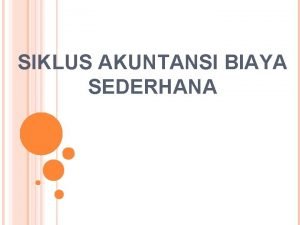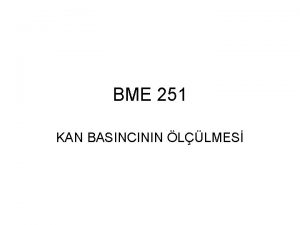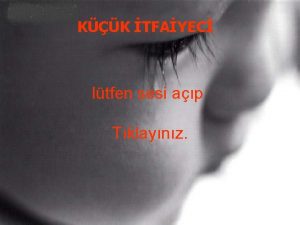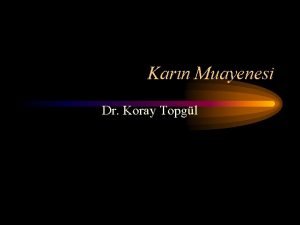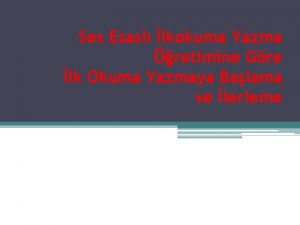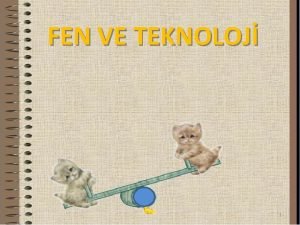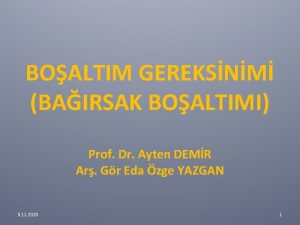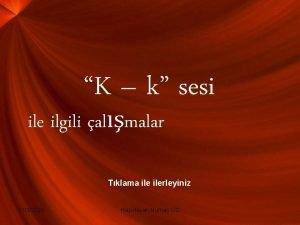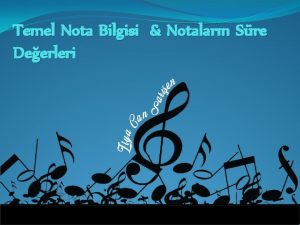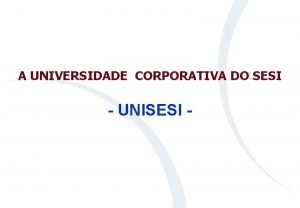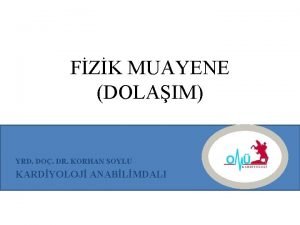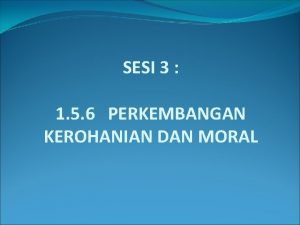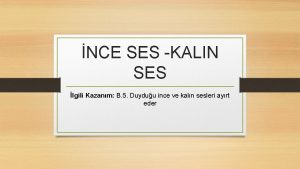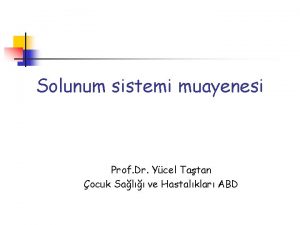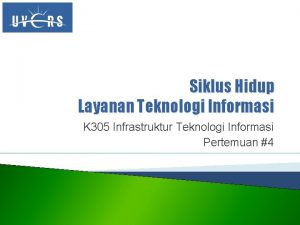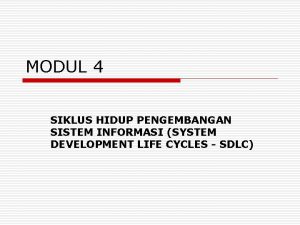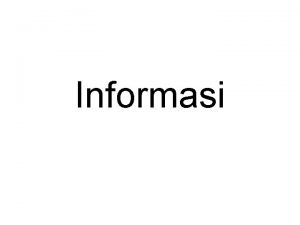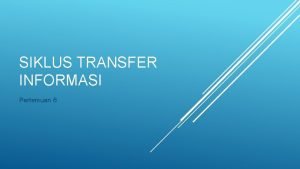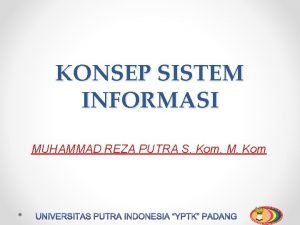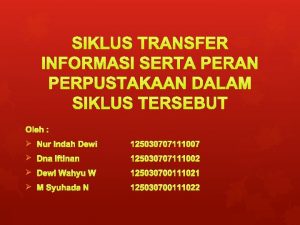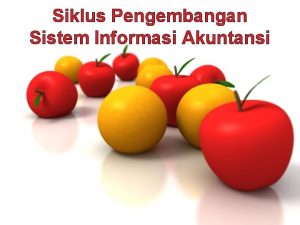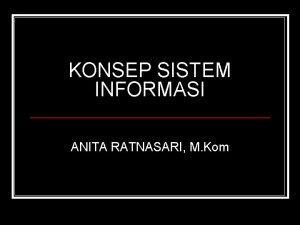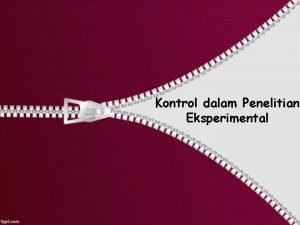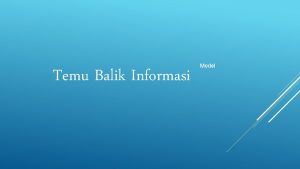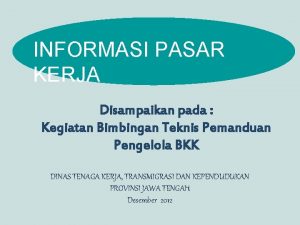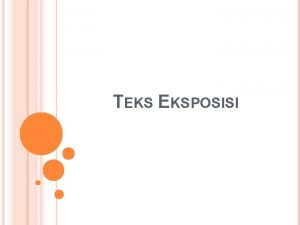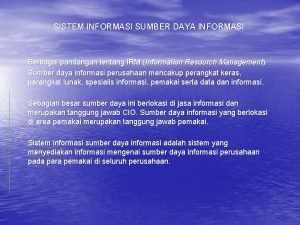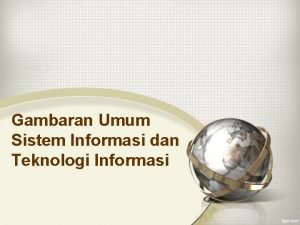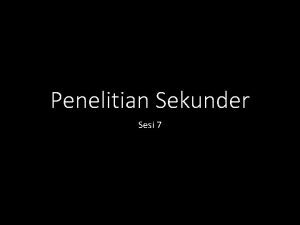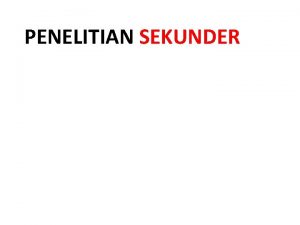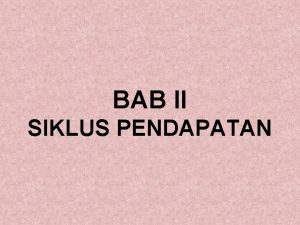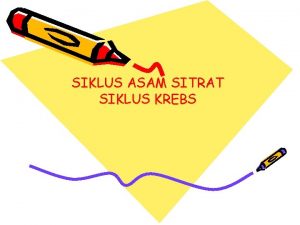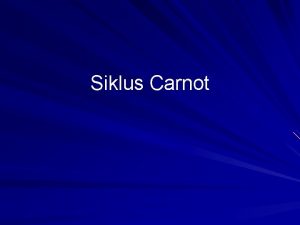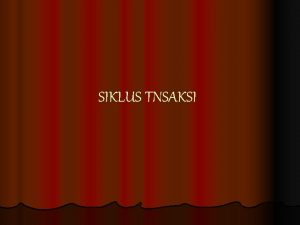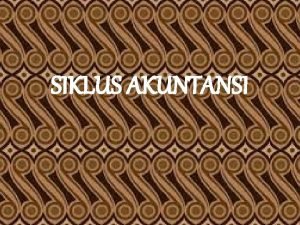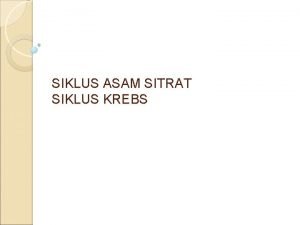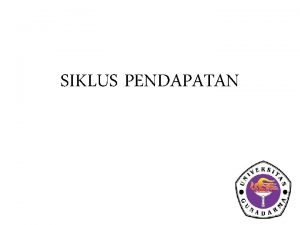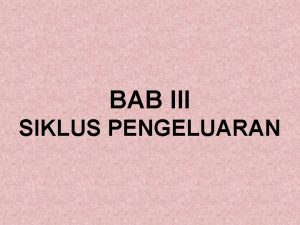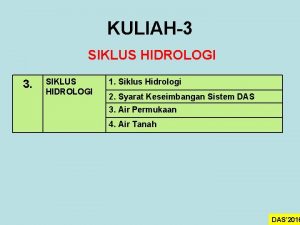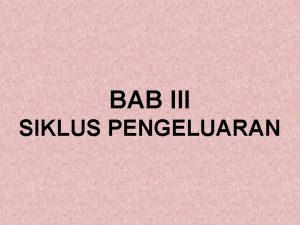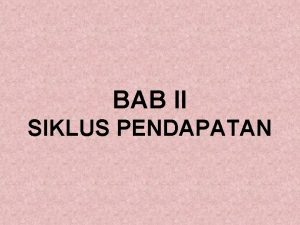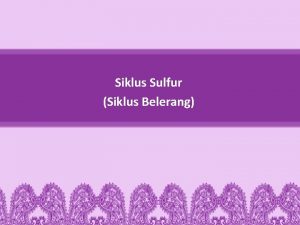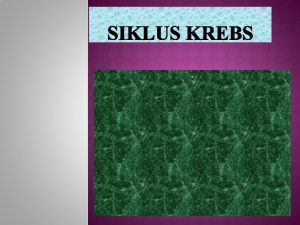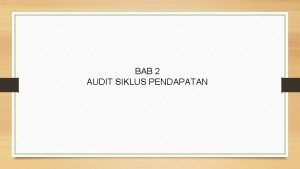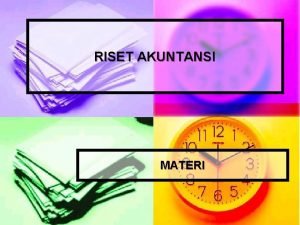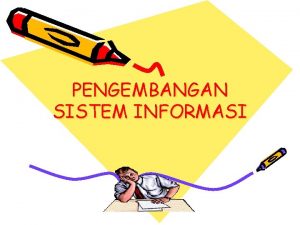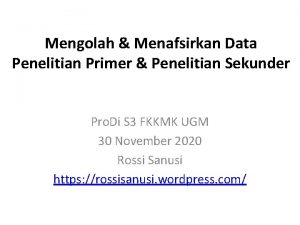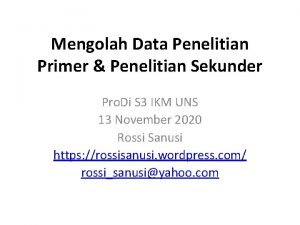Penelitian Sekunder Sesi 7 Siklus Informasi Penelitian Sekunder






























- Slides: 30

Penelitian Sekunder Sesi 7

Siklus Informasi

Penelitian Sekunder • Merupakan pendekatan penelitian yang menggunakan data-data yang telah ada, selanjutnya dilakukan proses analisa dan interpretasi terhadap data-data tersebut sesuai dengan tujuan penelitian. • History research, trend analysis, SWOT analysis, forecasting analysis, dsb.

Keuntungan Penelitian Sekunder • Murah • Data dapat dikumpulkan/didapatkan dengan cepat • Dapat belajar dan mengerti kejadian di waktu lampau • Akan dapat meningkatkan pengetahuan melalui replication dan menambah jumlah sampel • Pada penelitian sosial, dapat memahami perubahan social (social change)

Kerugian Penelitian Sekunder • Keakuratan data tidak terjamin hasil interpretasi peneliti sebelumnya • Data yang tersedia kadang tidak sesuai dengan kebutuhan • Unit pengukuran yang berbeda • Usang (tidak up-to-date)

Metodologi umum dalam penelitian sekunder • Mencari dan mengumpulkan data • Membuat agar unit pengukuran yang digunakan dapat dibandingkan (comparable) • Mengevaluasi data/dokumen • Menentukan kelengkapan data • Melakukan analisa data


Sumber-sumber informasi

Evaluasi Sumber Informasi • Bagaimana menentukan sumber informasi yang sesuai (best source) ? • Suatu sumber informasi bisa jadi sesuai untuk seseorang, namun tidak untuk yang lain, tergantung dari tingkat keperluan masing-masing orang tsb dan kemampuan untuk mengevaluasi sumber informasi.

Guide to Preliminary Evaluation • If you are evaluating a book, reading the whole book is not necessary at this point. • For the initial evaluation of a book or article, ask yourself the questions below • What does the title tell you? • Sometimes the titles conveys a lot. • Sebagai gambaran awal dalam menentukan kelayakan sebuah dokumen/data.

Guide to Preliminary Evaluation (2) • Who is the author? • Look for information about the author at the front of the book, at the end of the book, on the cover and in the preface or introduction. Consider these two points. • Bagaimana kualifikasi penulisnya ? • Kaitan latar belakang penulis dengan topiknya, apakah terdapat bias ? • For example, if your topic is "gays in the military, " will a gay person and a non-gay person necessarily look at the issues in the same way? If you are writing about Native American history, do you want the views of only European-Americans or also the views of some Native Americans?

Guide to Preliminary Evaluation (3) • When was it published? • Jika waktu menjadi hal yang penting terhadap data, maka hal ini harus menjadi hal yang penting untuk diperhatikan, misal data sensus, data penjualan, data revenue, dsb. • Does the date affect the usefulness of the material for your research? Why or why not? • Beberapa hal dapat menjadi bagian dari latar belakang • If you are writing about something that happened a long time ago, the date of a source is less important. Yet keep in mind that even though the facts about an issue or an event of the past probably haven’t changed, society’s attitudes might have changed a lot. • Does the source have any special features such as statistics, maps, charts or lists of dates? • Flip through the book. Sometimes there is a list of illustrations at the front or back. • Is the presence or absence of these features important? Why or why not?

Guide to Preliminary Evaluation (4) • Is it easy to find what you need? • Lihat daftar isi atau index • What is the scope of the book or article? In other words, what is the author trying to cover? • Buku baca pendahuluan, daftar isi, pengantar penulis • Artikel baca abstrak, atau paragraph awal/akhir dari pendahuluan • Be specific. For example, do not simply say to yourself "This book is about American history. " A better answer would be "This book covers American history starting from the arrival of the first European settlers in the 1600 s and ending with the conclusion of World War II. It includes politics and economic issues but not social customs or the effects of the war. "

Guide to Evaluation in Depth • What is the author’s main point or argument? • Dengan kata lain, apa topik utama dan argumen yg digunakan penulis yg menggambarkan tujuan penulisannya. • How well does the author support the main point or argument? • Does he or she use evidence such as facts, quotes and examples? • Where did the author get his or her information? • Look for footnotes or other references to sources or people. Some of these resources might be helpful for additional research.

Guide to Evaluation in Depth (2) • Does the source contain primary material, secondary material, or some of each? • Is that important? Why or why not? • Is there any indication of bias? • Bias is prejudice or lack or objectivity toward the topic. It’s sometimes obvious from the author’s identity or background, which were first mentioned in the preliminary guide. Yet often it is more subtle and can be detected only by careful consideration of the material.

Getting the Best Information • The best research requires the best information. Not every item on your topic is equally useful or appropriate. Before you wrap up your research see if your material passes this test of quality. • Current • This is harder than it looks. If you are looking for recent material then you need to make two checks on your information. • First: When was it published? The difference between 1980 and 1990 is enormous if you are studying U. S. /Soviet relations. While magazines and journals will generally be more current than books, on certain hot topics even a book will get rushed into print. • Second: When was the information it is based on published? Look at the items in the footnotes and bibliography. When were they published? Are the statistics as recent as they might be?

Getting the Best Information (2) • Valid • Most people forget to consider this point. Libraries try to collect a wide variety of material for a wide variety of uses. If you are doing serious research then you need to choose the most authoritative sources available in the library so consider two points. • First: Do you know anything about the author's credentials? In some magazines the same author who writes this week on AIDS wrote last week on lawn mowers. Did the author of your book get a degree in or work on the subject? • Second: What about the publication's reputation? Some publications are less reliable, authoritative, and accurate than others. As one extreme, just think of the supermarket tabloids.

Getting the Best Information (3) • Objective • It is almost impossible for anything to be entirely objective. Everyone has, at least, a cultural bias. A Japanese author may view dating rituals differently than a British author would. It's not that one is right or wrong, but that the researcher must understand the author's perspective. Check at least these two points. • First: Does this author have an ax to grind? If a member of the N. R. A. is writing about gun control then you shouldn't accept that view alone. Ask a librarian if your sources are well balanced between, for example, conservative and liberal views. • Second: Does time make a difference? An objective opinion at one point in time might be totally different at another point in time. It is possible, for example, to find quotes from reputable American leaders in praise of fascism and Mussolini. But those quotes will be from the mid-1930's, not from the mid-1940's.

Getting the Best Information (4) • Complete • Everyone has something they tend to forget when doing research. Ask yourself these questions to find your blind spots. • First: Is there a format of information that would still help? Did you try computers, statistics, maps, books, newspapers, scholarly journals, popular magazines, personal interviews, and any other relevant types of information? • Second: Did you answer every question you needed to answer in order to prove your thesis? Did you look at your research for its holes and weaknesses? • Original • Finally, are your sources as close to the original as they can be? For example, in studying President Reagan’s policies concerning people with AIDS, you can either read what he has to say on the topic or what someone else has to say. They both have some value but it is important to get the original source whenever possible so you make your own judgment and analysis

Evaluating Information from the World Wide Web • The Web presents special challenges for evaluating information. Because anyone can publish information on the Web, web pages don't necessarily go through the editorial process that most print pages go through. • First, consider the purpose of the site you're evaluating. Is it educational? Commercial? Is the site advocating a particular point of view, or does it appear to provide unbiased information? Ask yourself why the person or organization is providing this information. . . then evaluate web sites based on: • Accuracy • Is the information correct and accurate? Has it been fact checked? Where did the information come from?

Evaluating Information from the World Wide Web (2) • Authority • Who is the author and what are his or her credentials? Is there a publisher with editorial oversight for the publication? • Currency • Is there a date indicating the age of the information? Can you tell whether the date indicates when the information was first posted, when it was updated, or when it was first created? • Objectivity • Is there evidence of bias? Is the site attempting to sway you on one direction or another? • Coverage • How complete is the information?

Jurnal • Artikel riset dalam jurnal biasanya paling tidak memuat 5 hal, yaitu: • • • Abstract Introduction Methods Results Discussion

Abstract • The abstract usually contains a concise summary of : • • • the article's problem under investigation or the hypothesis, pertinent information on the participants, brief review of methodology, statistical analyses, results of the study, and implications of the study. • Jangan hanya menggunakan abstract ketika menginformasikan ttg suatu topik • Gunakan asbtrak hanya sebagai panduan untuk menentukan apakah paper tsb layak/berkaitan atau tidak !

Introduction • Merupakan body of paper, biasanya berisikan: • pengenalan masalah • It begins with a broad statement of the problem under investigation and then proceeds to narrow the focus to the specific hypothesis or hypotheses of the study. • Tujuan, signifikansi, hipotesis • The purpose of this section is to introduce the reader to the overall issue/problem that is being tested and to provide justification for the hypothesis or hypotheses. • Literatur review • In order to accomplish these tasks, the author needs to review past research on the same topic, discussing their findings.

Methods • The purpose of the Method section is to provide a detailed description of how the study was conducted. Think of this section as being a recipe with an exact description of how to replicate the study. This section is usually divided into subparts: • Participants/Subjects Sampling • (Participants is the term used when humans are involved in the study while Subjects is the term used when animals are in the study. ) • This subsection contains information such as: • number of participants and how they were selected & assigned (e. g. , at random? ) • major demographic characteristics (e. g. , sex, age, race, ethnicity, level of education, socioeconomic status) • etc

Methods (2) • Materials/Apparatus/Measures • All physical aspects of the research design are described in this subsection. It lists everything that was used in the study to help others replicate it (think "ingredients" for cookies). • Procedure • This subsection provides a detailed account of what happened in the study (think "directions" for making cookies).

Result • The Results section is the statistical reporting of the data. Its purpose is to describe what was found. • Typically, the writer presents the descriptive statistics first (e. g. , summary of the characteristics of the data) followed by the inferential statistics (e. g. , statistics related to the testing of the hypothesis). • Tables and figures are often used to convey important information in an organized manner.

Discussion • The Discussion section reviews, interprets, and evaluates the results of the study. • The review of the results is done is non-technical language, using no statistical markings. • Discussion sections typically begin by listing the hypothesis or hypotheses and then stating if the results supported or contradicted the hypothesis or hypotheses. • Next, writers usually discuss similarities and differences between the current findings and findings of previous research. • Any weaknesses of the current study are also reviewed and suggestions are made on improving the research design. • Finally, a discussion section usually ends with the writer providing directions for future research. • The discussion section begins with a narrow focus on the findings of the study and then proceeds more broadly by drawing conclusions until it ends with future implications.

Kapan harus menulis kutipan ? • Whenever you use another person's work, you must identify the work by using a standard citation format. • Whenever using information which is not general knowledge and it is the result of another author’s work. • Whenever the source of the information is important to supporting an idea or argument and the reader needs to be convinced of the authority of the information. • Whenever another author’s words or conclusions are quoted, paraphrased, or summarized. • Sumber yg dikutip dapat ditaruh di footnote atau di daftar referensi • Jangan mengutip namun tidak dituliskan sumbernya atau sebaliknya, dituliskan sumbernya namun tidak pernah dikutip !!!

Referensi • Singleton, “Approaches to Sosial Research 3 rd Ed”, Oxford UP, 1999. • Research Methods and Strategies, http: //www. seattlecentral. org/faculty/lkanne/text book/
 Siklus akuntansi biaya
Siklus akuntansi biaya Fonokardiyogram
Fonokardiyogram Sesi ap
Sesi ap Metalik barsak sesi
Metalik barsak sesi Elakin ses grupları
Elakin ses grupları Sonar cihazının sesi duyulur mu
Sonar cihazının sesi duyulur mu Normal barsak sesi dakikada
Normal barsak sesi dakikada Nurhan uz n sesi
Nurhan uz n sesi Daha dün annemizin notaları
Daha dün annemizin notaları Unisesi
Unisesi Venöz hum
Venöz hum Penakulan
Penakulan Duyduğu ince ve kalın sesleri ayırt eder
Duyduğu ince ve kalın sesleri ayırt eder Vibrasyon torasik azaltan durumlar
Vibrasyon torasik azaltan durumlar Diagram rea siklus produksi
Diagram rea siklus produksi Siklus hidup layanan teknologi informasi
Siklus hidup layanan teknologi informasi Siklus informasi
Siklus informasi Siklus pengembangan sistem informasi akuntansi
Siklus pengembangan sistem informasi akuntansi Siklus informasi
Siklus informasi Siklus informasi
Siklus informasi Siklus pengolahan data sistem informasi akuntansi
Siklus pengolahan data sistem informasi akuntansi Personil pde
Personil pde Transfer informasi adalah
Transfer informasi adalah Sebutkan dan jelaskan siklus akuntansi
Sebutkan dan jelaskan siklus akuntansi Siklus informasi
Siklus informasi What is the purpose of a control sample in an experiment
What is the purpose of a control sample in an experiment Judul dan nama anggota kelompok informasi gambar informasi
Judul dan nama anggota kelompok informasi gambar informasi Pengertian informasi pasar
Pengertian informasi pasar Memaparkan atau menjelaskan informasi-informasi
Memaparkan atau menjelaskan informasi-informasi Sumber daya informasi
Sumber daya informasi Gambar sistem informasi
Gambar sistem informasi
